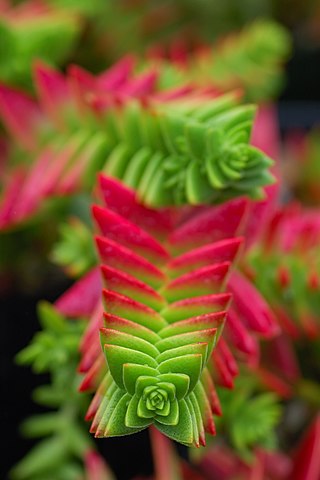
Crassula is a genus of succulent plants containing about 200 accepted species, including the popular jade plant. They are members of the stonecrop family (Crassulaceae) and are native to many parts of the globe, but cultivated varieties originate almost exclusively from species from the Eastern Cape of South Africa.

Dimorphotheca is a genus of plants in the family Asteraceae, native to southern Africa. is one of eight genera of the Calenduleae, with a centre of diversity in Southern Africa. Species are native to Botswana, Eswatini, Lesotho, Namibia, South Africa, and Zimbabwe. Some species can hybridize with Osteospermum, and crosses are sold as cultivated ornamentals. The name "Dimorphotheca" comes from the Greek "Dis" "Morphe" and "Theka", meaning "two shaped receptacle", referring to the dimorphic cypselae, a trait inherent to members of the Calenduleae. Plants of this genus usually have bisexual flowers.

Disa bracteata, also known as the bract disa, leek orchid or the South African weed orchid is a species of orchid native to South Africa.

Moraea aristata is a species of flowering plant in the family Iridaceae. It is referred to by the common names blue-eyed uintjie or Blouooguintjie in Afrikaans.It is endemic to the city of Cape Town and is considered to be critically endangered.

Dimorphotheca pluvialis, common names white African daisy, Cape marigold, weather prophet, Cape rain-daisy, ox-eye daisy, Cape daisy or rain daisy, is a plant species native to South Africa and Namibia. It is sparingly naturalized in scattered locations in California.

Dimorphotheca cuneata, commonly known as the rain flower or white bietou, is a plant species native to the Cape Provinces and Free State of South Africa. as well as the Botswana and Namibia. It is also widely grown as an ornamental and reportedly sparingly naturalized in Gila County in the US State of Arizona.
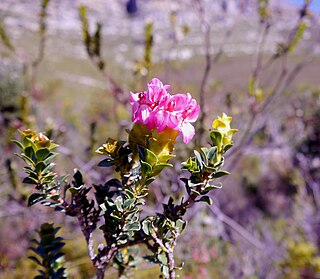
Penaea sarcocolla is a species of shrub in the genus Penaea. It is endemic to the Western Cape, along the coast up to Cape Agulhas and extending inland to Franschhoek, Hottentots Holland Mountains, Villiersdorp and Genadendal. It is also known as the Cape fellwort.

Willdenowia incurvata is a species of flowering plant in the genus Willdenowia endemic to the Fynbos region of the Northern Cape and Western Cape. It is also known as the sonqua sunreed; or sonkwasriet in Afrikaans.
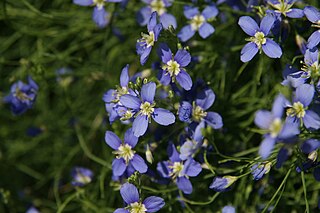
Heliophila coronopifolia is a species of flowering plant in the genus Heliophila. It is native to the Northern Cape and Western Cape provinces of South Africa.
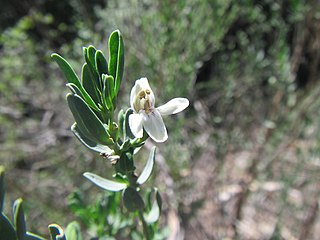
Justicia cuneata is a species of shrub in the genus Justicia. It is endemic to the Cape Provinces of South Africa.
Ursinia nudicaulis, also known as the longstalk paraseed or the little daisy is a species of plant from South Africa. It belongs to the daisy family.
Dimorphotheca dregei, or bietou, is a species of plant from South Africa.
Dimorphotheca acutifolia is a plant belonging to the genus Dimorphotheca. The species is native to the Eastern and Western Cape Provinces.
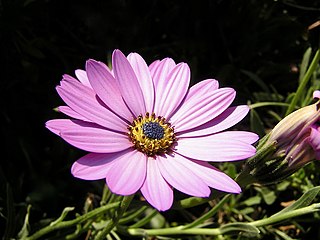
Dimorphotheca barberae is a plant belonging to the genus Dimorphotheca. The species is endemic to the Eastern Cape.

Dimorphotheca caulescens is a plant belonging to the genus Dimorphotheca. The species is endemic to the Eastern Cape, Western Cape and the Free State.
Dimorphotheca chrysanthemifolia is a plant belonging to the genus Dimorphotheca. The species is endemic to the Western Cape.
Dimorphotheca montana is a plant belonging to the genus Dimorphotheca. The species is endemic to the Western Cape.
Arctotheca forbesiana is a plant belonging to the genus Arctotheca. The species is endemic to the Western Cape and occurs from Malmesbury to Somerset West, Caledon and Elim. The plant is part of the fynbos and renosterveld vegetation. Although the area of occurrence is 4,266 km2, the area of occupation is smaller than 10 km2. The plant has given up large parts of its habitat to crop cultivation and suburban development, especially on the Cape Flats and at the Strand. The subpopulations at Faure, Kraaifontein and Raapenberg have been lost. Low-cost housing is also a threat at Caledon.
Arctotheca marginata is a plant belonging to the genus Arctotheca. The species is endemic to the Northern Cape and occurs on the Bokkeveld Mountains escarpment near Nieuwoudtville where it is part of the fynbos is. There are two subpopulations on one farm and they are threatened by overgrazing and the extraction of groundwater.

Berzelia albiflora is a shrub that belongs to the Bruniaceae family. The species is endemic to the Western Cape and is part of the fynbos. The plant's FSA number is 141.3













